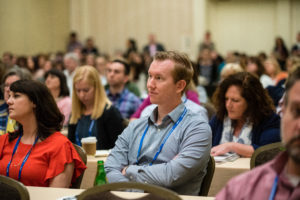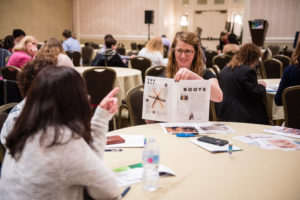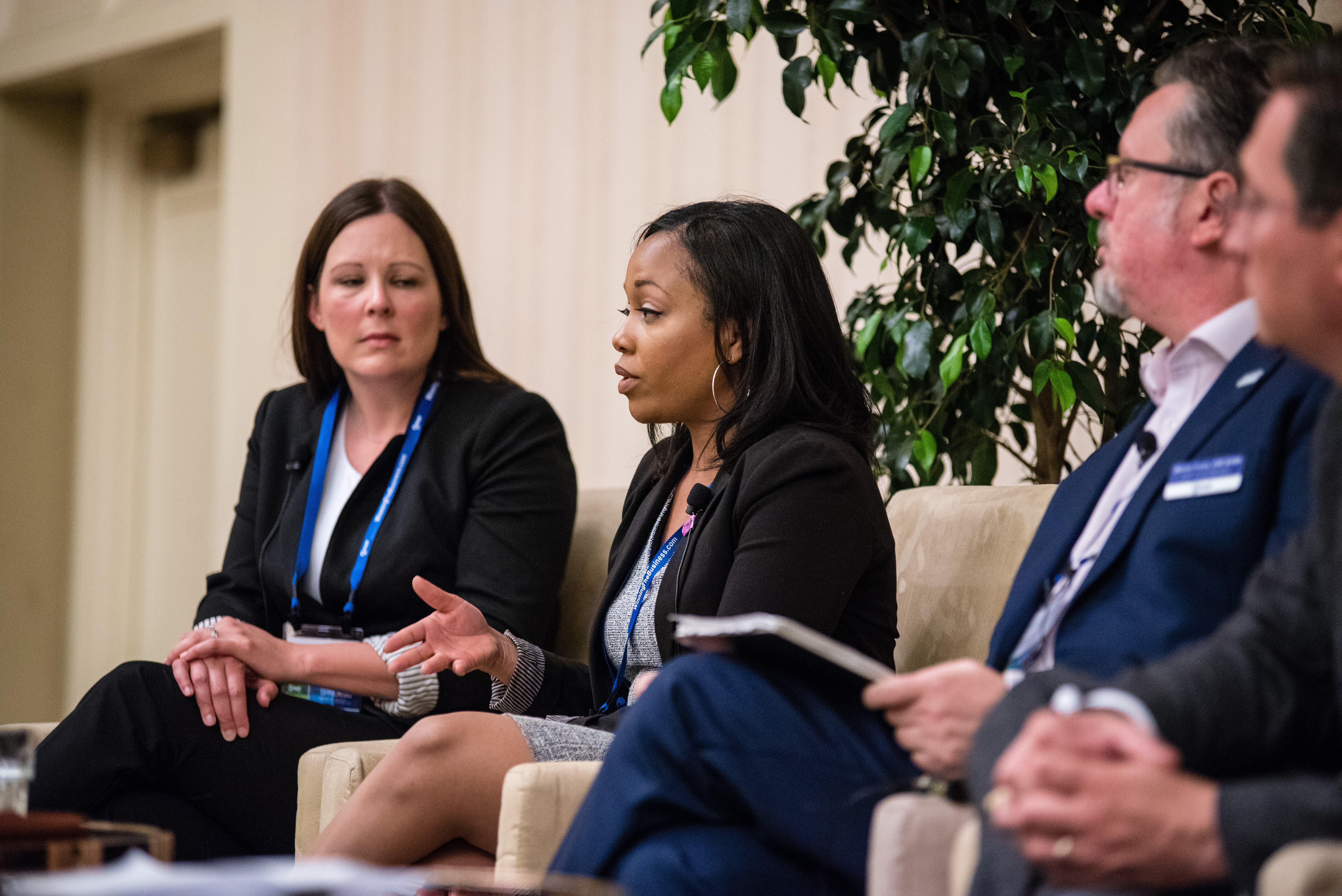The sessions at the 2018 Bid & Proposal Con follow four main tracks: leadership and professional development, managing processes, win the business, and tools/tech. Highlights from a few of the sessions on May 16 are below.
Latest Gadgets, Tools, and Tech for Proposals
Chet Hayes, CTO of Vertosoft,;William Rogers, Vice President and Chief Workplace Architect of R3 Business Solutions LLC; and Beth Wingate, President of Lohfeld Consulting Group, led an interactive panel on tech solutions for personal and professional problems. Both the panelists and members of the audience shared some of their favorite tools for productivity, collaboration, and completing specific tasks.
A few of the specific tools included:
- Todoist, an app that keeps one to-do list on all of your devices. Items can be labeled with a specific day and time, the user can assign priorities to tasks or assign a person to complete the task, and the user can upload documents.
- Acrolinx, content optimization software that provides a score on tone, readability, etc., to help the user write stronger pieces of content as well as help management have a bar for measuring a document’s level of quality (the audience member compared it to Grammarly).
- PleaseReview, document review, co-authoring, and redaction software that allows for concurrent collaboration with multiple users in real time (although one audience member suggested regularly refreshing the document). Users can accept or comment on other people’s comments, and once the review is over, the program extracts all the comments from the document. The program is linked to Microsoft Office, making it easy to add internal reviewers, but external reviewers can get access with a login and password.
- Microsoft Teams (part of Office 365), group chat software that includes document sharing and subgroups that limit conversations and documents to just a specific group of people, keeping the entire conversation organized in one location.
- PerfectIt, proofreading software that allows the user to upload a style guide and, through a Microsoft Word plug-in, check a specific document against a specific style guide.
- Visible Thread, a shredding tool that can shred down at the sentence level and includes a readability score and an acronym extractor.
- Breethe, a mindfulness app that includes different types of meditation.
If your organization is already using one of the powerful tools like Microsoft Office 365, but you don’t see all of the tools available, the panelists reminded attendees to contact your IT department to make tools, like Teams, available to you.
Growing Seasoned Veterans from Young Professionals
Panelists Jody Alves, Senior Proposal Writing Specialist for International Game Technology (IGT); Felix Becker, Head of Bid and Proposal Management ANZ/Japan for SAP; Rebecca Link, Senior Proposal Manager for American Systems; Brian Murray, Manager of Proposals and Sales Operations for CapTech Consulting; and moderator Steve Kroger, Senior Manager of Proposal Development for Aerojet Rocketdyne, talked about ways that young professionals could take charge of their career development in the proposal industry and how seasoned professionals can provide support along the way.

Attendees enjoy sessions at the 2018 Bid & Proposal Con
Alves’ and Becker’s companies have found success through direct training and internship programs. Every spring, IGT has a class on proposal writing at the University of Rhode Island with projects that are designed to mimic the real aspects of the job. One student also gets a paid summer internship with the firm. While an intern would have a specific focus, like writing or graphics, they are involved in the entire process so that they can understand the big picture. SAP has grown their paid internship program from just one to now four interns. Becker explained that the program has been beneficial for both the interns and for seasoned professionals — the interns are directly involved in the proposal process and later provide a pool of candidates when the company is recruiting new talent, and the seasoned professionals are motivated by the interns’ desire to learn and reinforce basic concepts as they explain them to the interns.
Beyond interns, panelists addressed several ways that seasoned professionals can provide support to people newer to the industry. Kroger encouraged veterans to take the time to share their knowledge with and mentor young professionals and give back to the industry, whether that’s through their company, their chapter, or the association. Murray encouraged veterans to help expose young professionals to all facets of the industry. Link expanded on this by pointing out the difference between a manager and a leader is that a leader cultivates growth among their team members and rewards progress and dedication.
Growth was a major theme for young professionals looking to develop into seasoned professionals. Link and Murray especially emphasized the importance of taking control of your own career management, determining your ambitions for your career, and setting specific goals within specific timeframes. Young professionals then need to communicate their goals and ambitions to their superiors, build in the training that they need to work towards those goals, and reevaluate where they are every time they’re supposed to hit one of their goals. Murray also suggested getting incremental feedback on projects throughout the year. “Think like a sponge,” Link repeated throughout the session, and panelists all agreed that the proposal profession was one of continual learning.
Networking, developing interpersonal relationships, and building rapport were also tools that young professionals could use to learn and grow. Panelists pointed to the experience among Bid & Proposal Con attendees and encouraged young professionals to reach out, make connections, and find colleagues to reach out to with questions.
Persistence and resiliency were two traits that came up throughout the session, but panelists also stressed that young professionals need to think about what they bring to the table and where they can fit into the industry. Link said that career progression is like a tic-tac-toe board — sometimes the logical next step isn’t simply straight up but to the side or diagonal. There are many ways a developing professional can find their fit within the industry. But if it becomes clear that proposal writing is not where someone is meant to be, panelists pointed out that many of the skills developed in the proposal industry are valuable in many other capacities. Think about what you’re doing, Alves said, adding that a proposal isn’t just a document that goes into a binder to get reviewed. It keeps the business going, it creates jobs, it builds industries. A proposal is an important thing.
Five-Star Executive Summaries
Jay Herther, Vice President of Business Winning for BAE Systems; Betsy Blakney, Director of Proposal Management for CACI Inc.; Jon Williams, Managing Director of Strategic Proposals; Mike Parkinson, Principal at 24 Hour Company; and moderator Bobbie O’Brien, Proposal Manager for Assured Information Security Inc., presented an engaging panel on traits of winning executive summaries and what to avoid.

Attendees enjoy sessions at the 2018 Bid & Proposal Con
The characteristics of a strong executive summary came down to a few themes: focused on the customer, demonstrate understanding of the customer’s needs, easy to read or even skim (including keeping to shorter page limits), provide a road map for the rest of the proposal, and give the customer a reason to trust the company. After working on the executive summary, you should be able to summarize the entire proposal in one sentence and then use that sentence to inspire the killer graphic, said Parkinson.
On the flip side, weak executive summaries are inauthentic (perhaps a repeated template), focus more on the company than the customer, are text-only, use trite and cringe-worthy phrases like “best in class” or “thank you for the opportunity” or “uniquely qualified,” and overall are just plain boring or difficult to read.
But the executive summary is valuable not just for the customer but for the company as well. Panelists generally agreed with writing the executive summary first, although they also said the summary should be the last thing edited and should be continually reviewed and revised as the proposal is being developed. The executive summary is the big picture of what value the company will bring to the client, and it should have bold statements. Writing the executive summary first then gives the team the opportunity to coalesce under a single vision and, since every claim in the summary needs to be substantiated in the proposal, it gives the writers a roadmap for how to move forward while completing the rest of the project. When an audience member raised the point that she was starting to see RFPs that don’t require an executive summary, panelists suggested writing one anyway and possibly including it anyway but under a different name, like the solution at-a-glance or customer value highlights. Trust is the closest thing to a silver bullet in proposals, said Parkinson. You need to show that you understand why the customer wrote the RFP in the first place.
Other tips for writing a strong executive summary include:
- Repeat benefits over and over again throughout
- Use white space
- Customize it for the customer — use their colors, etc.
- Read it out loud to check if the wording is working or not
An audience member suggested practicing by writing executive summaries for a favorite movie during a workshop, and then having attendees give each other feedback on whether they would see that movie or not based on the executive summary and why.
Panelists see executive summaries as staying just as important or becoming more important in five years, and Herther sees video becoming more important as attention spans get short.
Business/Commercial Town Hall
The Business/Commercial Town Hall focused on small shops, although the first question was to define what “small” meant, understanding that the definition varied. Definitions included having a small staff, pursuing smaller bids, immature proposal capabilities, being in a company that isn’t dependent on proposal revenue, or even having a large department that was understaffed or under-resourced (thus, smaller than they should be).
One conversation revolved around the scope of the proposal professional’s role, especially since many people in small shops tend to wear many hats. Sometimes this was a negative, especially if the company began to rely on the proposal department for too many elements of the proposal process. Others argued that playing multiple roles was an advantage because it helps the individual provide more value to the business and have more control over the process and get involved earlier.
Another conversation focused on company growth. As a company grows, the proposal professional may need to educate management – and perhaps the rest of the company – on their role and how the process should work. This education can come down to simply tracking the time it takes to do each element of different types of proposals, especially if the goal is to convince management to budget for more staff or resources.
Audience members also talked about resources they would like from APMP, especially guidance in terms of finding and evaluating tools. Suggestions included having a chart of vendors that fall into different categories, providing generic data on the ROI for different types of tools, having a rating system to help narrow the field, and even having an RFP template for small shops to send to vendors they might be interested in working with.
At the end, APMP Chair Jamie Ninneman had audience members raise their hands in answer to challenges they have successful faced so people who had questions about those challenges could easily connect with someone for advice.
Save the date! Bid & Proposal Con 2019 will be June 3-6, 2019, in Orlando, Florida. Look for registration to open in early 2019.



Interesting to read about “white space” – something that I’ve known about it for a while – because I have just been working on a public tender in the UK and one of the requirements was “avoid too much white space”. Presumably being a public sector organisation the buyer is conscious of wasting resources like paper, was my first thought. But then I know that this organisation do not print proposals as they evaluate them online, so why not white spaces? That shows that there is always the exception to the rule.